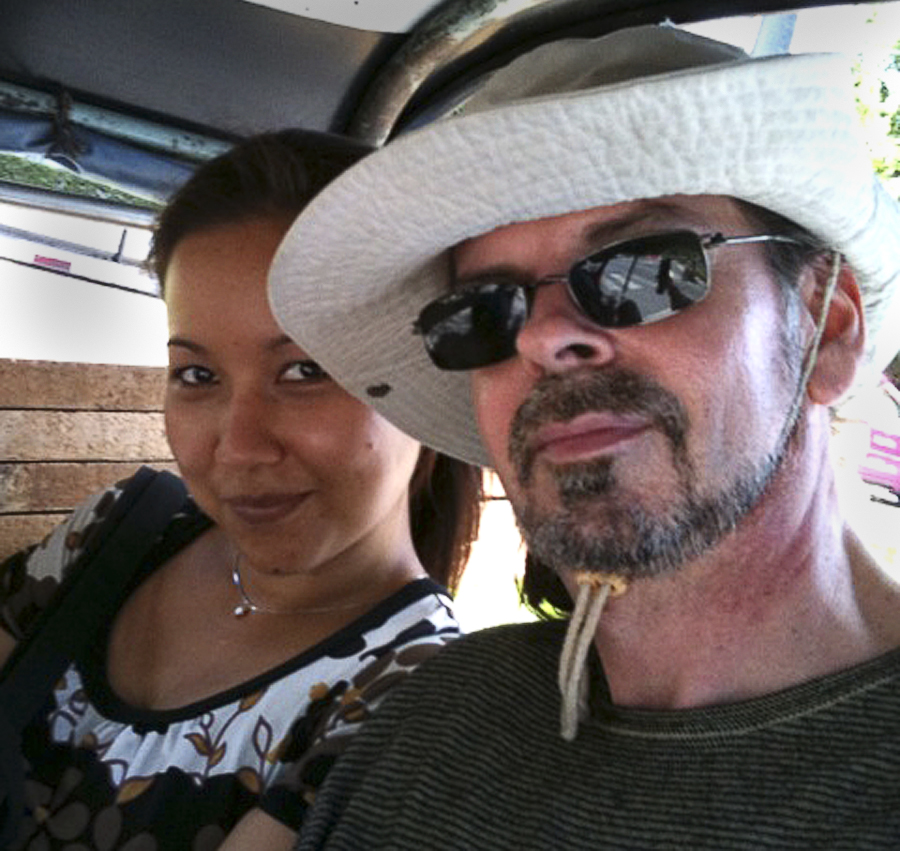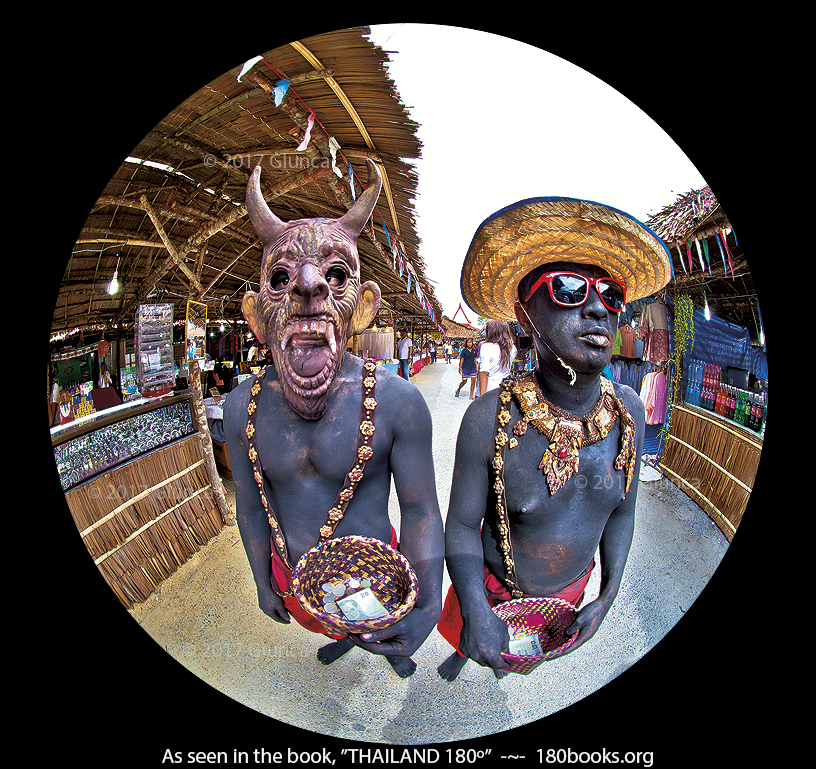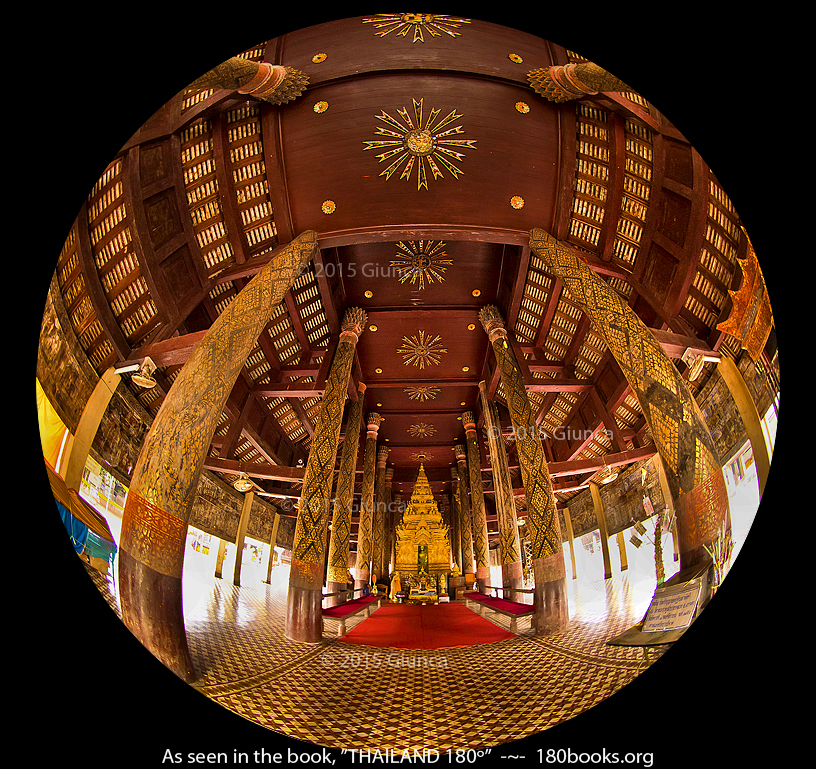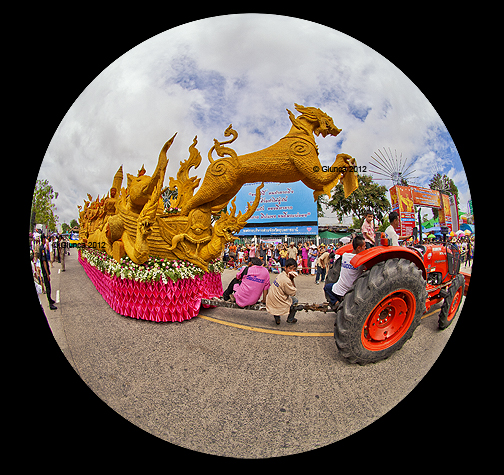Animism and Spirits in Thailand
When I learned that the #FriFoto theme for this week is #spirit, I immediately thought of animism. Animism comes from the Latin word anima and means breath, spirit, and life. Animists believe that almost everything possesses a spirit including plants, animals, rocks, rivers, wind, sun, and other inanimate natural objects and that the physical world and spiritual world are intertwined. Many people in Asian countries share this point of view, especially in Thailand, where I’ve lived for the past ten years. Animism is such a part of their everyday life that there’s no word in their language to describe it. It’s simply what they believe and practice on a daily basis! In this blog, I’ll present some photographic examples of this, after a brief quote that sums up this topic well.
“Animism is not a belief system, but a worldview: The world is a sacred place, and we are part of it. The factuality of this statement is not the issue. To say that the world is a sacred place is to make a statement about values, not facts. It’s a statement about what you mean by ‘sacred,’ just as ‘Money can’t buy happiness’ is a statement about what you mean by ‘happiness.’ To put it all very simply, animism isn’t a belief system; it’s a value system.”
Daniel Quinn
~~~~~~
***คำเตือน: โปรดใช้สติและวิจารณญาณในการอ่าน***
เวลาพูดถึงคำว่า “วิญญาณ หรือ Spirits” หลายคนมักนึกถึงเรื่องผี ดวงวิญญาณ และสิ่งลี้ลับ รวมถึง “แอนนิมิสซึม (animism)” หรือ “การนับถือวิญญาณ” อันเป็นความเชื่อที่ว่าทุกสรรพสิ่งในธรรมชาติและจักรวาลจะมีชีวิตหรือไม่มีชีวิตต่างมีวิญญาณอันมีมาตั้งแต่ก่อนยุคประวัติศาสตร์ การนับถือวิญญาณในภูมิภาคเอเชียและประเทศไทยก็มีมานานก่อนที่จะมีศาสนาต่างๆ เข้ามาเผยแพร่ โดยแต่ละภูมิภาคก็เลือกที่จะรับบางส่วนของศาสนามาผสานกับการนับถือวิญญาณของตนเพื่อให้เกิดความน่าเลื่อมใสศรัทธา จนบางทีเราก็ไม่ได้นึกถึงหรือไม่ทันได้คิดว่าสิ่งที่เราเคารพบูชานี้คือ พุทธศาสนา หรือการนับถือวิญญาณ หรือการนับถือเทพ เพราะเราเติบโตมากับสิ่งนี้ พบเห็นสิ่งนี้ในชีวิตประจำวัน และปฏิบัติกันเรื่อยไปแบบที่ไม่คิดว่าจะเป็นการขัดแย้งกันจนกลายการผสมผี-พราหมณ์-พุทธไปด้วยกัน เป็นการนับถือศาสนาแบบไทยๆ ยกตัวอย่างเช่น
The Spirit that Guards the City of Angels
The first time I visited Bangkok, my Thai friends all had the same advice: Go to the Lak Muang Shrine and ask the spirit to help guide and protect you while living in the Kingdom. The Thais believe that the guardian spirit of the city lives in this shrine. Well, who am I to question such advice? Of course, I went, and it was so fascinating that I spent most of the morning there. You can read more about Lak Muang right Here.
ศาลหลักเมือง
เมื่อใดก็ตามที่จะมีการสร้างเมืองใหม่ขึ้น สิ่งที่จะต้องทำเป็นประการแรกคือ หาฤกษ์ยามดี สำหรับตั้งเสาหลักเมืองหรือเสาอินทขีล แล้วจึงจะดำเนินการสร้างบ้านสร้างเมืองกัน ซึ่งเมื่อสร้างเมืองเสร็จเสาหลักเมืองนั้นก็จะเป็นสิ่งศักดิ์สิทธิ์ที่เคารพบูชาของชาวเมืองนั้นๆต่อไป การตั้งหลักเมืองหรือขีลเป็นธรรมเนียมพราหมณ์ (ภาพศาลหลักเมืองด้านล่าง เป็นหนึ่งในแลนด์มาร์คของกรุงเทพมหานคร)

Lak Mueang and the City Pillar of Krungthep (Image from the 180books.org Photo Collection by George Edward Giunca)
Spirit Houses
While exploring the city, I noticed that there was a small house with offerings and sometimes small statues on the property of almost every house and even some office buildings. These are spirit houses called san phra phum. Sometimes I’d watch as the locals brought flowers, water, and food to the small houses. They would place the offerings, light incense, bow their heads to pray and wai (the Thai greeting and show of respect) before continuing on their way. I later learned that before a building is erected on a property, a Medium is asked to contact the spirit that lives on the land and find out what type of spirit he or she is, so that a small house of the correct type can be built for them. This makes sure that the spirits are appeased and will protect the main house, and it’s owners. The photo below shows a house made for a San Ta Yai, a grandfather spirit. Sometimes it’s easy to recognize the nature of the spirit by looking inside the house. In the same photo, you can see a well-aged bodhi tree with ribbons wrapped around it. Yes, the spirits in trees deserve respect too.
ศาลพระภูมิ ศาลตา-ยาย
การตั้งศาลพระภูมิก็เป็นประเพณีพราหมณ์เช่นกัน ไม่ต่างจากการตั้งเสาหลักเมืองที่คนไทยเราปฏิบัติจนกลายเป็นขนบประเพณี ส่วนศาลตายายที่เราเห็นมักเป็นแบบบ้านทรงไทยมีสี่เสาโดยตั้งขึ้นเพื่อให้เป็นที่สถิตของวิญญาณของผู้ที่เคยอยู่อาศัยในที่ดินผืนนั้นมาก่อน เขาจะได้ไม่รบกวนและยังช่วยปกป้องคุ้มครองที่พักอาศัยเราด้วย พูดง่ายๆ คือเป็นความเชื่อในคติการนับถือวิญญาณหรือศาสนาผีของท้องถิ่นไทยเราเอง บางครั้งจะเห็นทั้งศาลพระภูมิและศาลตายายตั้งคู่กันก็มี อย่างในภาพด้านล่างนี้เป็นศาลตายายตั้งอยู่ใกล้กับต้นโพธิ์อายุกว่า ๒๐๐ ปี กับความเชื่อว่ามีเทพยดานางไม้คอยอารักษ์และสถิตย์อยู่ภายใน

San Ta Yai Spirit House in Bangkok, Thailand (Image from the 180books.org Photo Collection by George Edward Giunca)
Meeting a Medium
Speaking of Mediums, below is a photo of none other than Chaopu Sisuttho. He is famous for channeling the spirit of the Great Naga. When I visited him at his home in Udon Thani, he went into a trance and had a vision of my past life. He told me that I was a strong willed spiritual person with a strong will and had been one of the Great Naga’s guards in my past life. Hmmm, I guess that would explain my lifelong affinity for snakes and reptiles!
การทรงเจ้า-เข้าผี
พุทธศาสนาไม่ได้สอนให้เราเชื่อเรื่องเทพเรื่องพรหม ฝนเองก็สงสัยในบทความทั้งหลายที่เขียนเหตุเล่าความถึงองค์สมเด็จพระสัมมาสัมพุทธเจ้าก่อนเสด็จดับขันธ์ปรินิพพาน ว่า …ผู้ใดจะเป็นผู้ดูแลศาสนา แล้วพระอานนท์ทูลว่าพุทธบริษัท ๔ จะเป็นผู้ดูแลและบำรุงพระศาสนาเป็นเวลา ๒,๕๐๐ ปี จากนั้นเหล่าเทพเทวาทั้งหลาย ขอให้ปวงเทพได้ดูแลและบำรุงพระพุทธศาสนาต่อไปอีกครึ่งหนึ่งของพระอานนท์คือ ๑,๒๕๐ ปี แล้วเหล่าพญาครุฑ คนธรรพ์ นาคราช ท้าวกุเวร กินนร กินนรี และภูติผีปีศาจ จึงกราบทูลขอดูแลอายุพระศาสนาเท่าที่เหลือ ๑,๒๕๐ ปี … อ้างว่านี่คือที่มาของการมีร่างทรงเพื่อให้เทพมาประทับร่าง จะได้สื่อสารกับมนุษย์และช่วยบำบัดทุกข์ร้อน … ความเห็นส่วนตัวของฝน คือ คนเราต่างก็มีทุกข์มีวิบากต่างกรรมต่างวาระ จะเป็นเทพ-พรหม-เจ้า-ผี-วิญญาณ ก็ไม่อาจกำจัดบ่วงกรรมของเราได้ แต่อาจช่วยให้หลายคนมีขวัญและกำลังใจที่จะยืนหยัดดำรงชีวิตได้ ทั้งนี้ฝนเห็นว่าการทรงเจ้าเข้าผีไม่มีความเกี่ยวโยงกับบทความอ้างถึงพระพุทธเจ้าและเหล่าเทพ-นาค-ผีในการดูแลบำรุงพุทธศาสนาแต่อย่างใดและไม่สมควรนำมาอ้างด้วย การทรงเจ้าเข้าผีเป็นความเชื่อความศรัทธาส่วนบุคคลที่สืบเนื่องมาจากการนับถือวิญญาณหรือการนับถือเทพดังที่กล่าวถึงตั้งแต่ต้น
ภาพด้านล่าง เป็นร่างทรงเจ้าปู่ศรีสุทโธ โดยเมื่อตอนที่เราไปคำชะโนดดินแดนระหว่างมนุษยภพและนาคภพ คนขับรถเล่าให้ฟังถึงร่างทรงอันเป็นที่เชื่อถือของคนที่นี่ คุณเอ็ดเวิร์ดยังไม่เคยมีประสบการณ์จึงอยากไปพบ เมื่อร่างทำพิธีเชิญเจ้าปู่ศรีสุทโธประทับร่างแล้วก็พูดคุยกับคุณเอ็ดโดยให้ฝนเป็นล่ามให้ ร่างทรงเจ้าปู่ศรีสุทโธบอกว่าคุณเอ็ดเวิร์เป็นคนที่มีจิตแข็งมีความตั้งใจสูง… และเมื่อภพภูมิหนึ่งเคยเป็นนาคอารักข์แห่งองค์นาคราช คุณเอ็ดเวิร์ดบอกว่าตรงนะ และก็ไม่น่าแปลกใจที่อดีตชาติเคยเป็นนาคนี่เองเลยเป็นคนชอบงูและพวกสัตว์เลื้อยคลาน

The famous Medium, Chaopu Sisuttho in a trance (Image from the 180books.org Photo Collection by George Edward Giunca)
Mae Naak Phra Khanong
Some spirits that were once evil have now turned their afterlife around and become benevolent. Thailand’s most famous ghost, Mae Naak Phra Khanong is one such spirit. There’s even a shrine dedicated to here next to a temple in Bangkok. Visitors to the shrine give her silk dresses, donate money to keep a television running, and toys for her child. In exchange for this, Mae Naak helps a couple out with difficult relationships, gives visions of winning lottery numbers, and helps young men avoid conscription. She is still feared by many, though. I was once admonished for speaking her name in a friend’s house! More HERE.
แม่นากพระโขนง
ความเชื่อเรื่องผี เหตุการณ์และเอกสารอ้างอิงทางประวัติศาสตร์ สู่บทประพันธ์ ภาพยนตร์ และโอเปร่า อันแสดงถึงตำนานความเชื่อที่ไม่หยุดอยู่กับที่ ไม่เสื่อมกาล และยังเพิ่มเติมเรื่องอิทธิฤทธิความน่ากลัวหรือความเฮี้ยนของนางนากตามแต่จะแปลความไปเพื่อให้เกิดความบันเทิงทางละครและภาพยนตร์ จนเป็นตำนานผีแม่นากพระโขนงที่โด่งดังมาหลายยุคสมัยแม้กระทั่งในปัจจุบันที่ความเชื่อเรื่องผีสางอาจลดถอยไปบ้าง แต่ที่วัดมหาบุศย์ยังคงมีผู้ศรัทธามากราบไหว้ขอพร ขอให้สมหวังในความรัก ขอให้รอดจากการเกณฑ์ทหาร ไปจนถึงขอโชคลาภและขอหวย!

Mae Naak Phra Khanong Shrine, Wat Mahbut in Bangkok, Thailand (Image from the 180books.org Photo Collection by George Edward Giunca)
For the Ancestor Ghost with Almost Everything…

Hi-Tech offerings for the ghost with 21st Century needs (Image from the 180books.org Photo Collection by George Edward Giunca)
In addition to paying respect or asking spirits for favors in daily life, there are holidays and festivals to honor them. On the 7th Lunar month, cardboard replica offerings are burned by some families, and the smoke carries the items off to the realm of the spirits. This not only provides ghostly ancestors with necessities but coaxes them to return the favor to the living. Above is a photo of Hi-Tech goods for that spirit with 21st Century yearnings. We covered this in a blog not long ago that you can read HERE.
การเคารพวิญญาณบรรพบุรุษ
การนับถือดวงวิญญาณบรรพบุรุษผู้ล่วงลับ นับว่าเป็นการเชื่อเรื่องวิญญาณมีอยู่จริง แม้จะตายจากไปแต่ยังเป็นที่เคารพและแสดงความเคารพนั้นผ่านพิธีกรรมต่างๆ อย่างเช่น เทศกาลสารทจีน บุตรหลานผู้ที่ยังมีชีวิตอยู่ จะจัดหาข้าวของเครื่องใช้ที่จำเป็นในการดำเนินชีวิตรวมถึงแผ่บุญกุศลให้แก่บรรพบุรุษผู้ล่วงลับ ส่วนใหญ่ทำจากกระดาษก็จริงแต่แสดงออกถึงความกตัญญู เมื่อเสร็จพิธีก็เผาส่งให้วิญญาณเหล่านั้น เช่น ธนบัตร, กำปั่น, ม้า, บ้าน, เสื้อผ้า, รองเท้า …. แต่นี่มันศตวรรษที่ ๒๑ แล้วนะ!!! เดี๋ยวนี้มันต้องไฮโซและไฮเทคยิ่งขึ้นด้วย iPhone, iPad, นาฬิกาโรเล็กซ์, กระเป๋าชาแนล, คอนโด, รถเบนซ์, เครื่องบินเจ็ทส่วนตัว,…
The Phii Ta Khon Festival

Men portraying Jungle Spirits, AKA Phii Pa (Image from the 180books.org Photo Collection by George Edward Giunca)
The Phii Ta Khon festival in Dansi, Loei has a very colorful parade that the whole town, as well as visitors, participate in. Different costumes represent different ghosts in this lively, colorful event. I highly recommend that you see this festival. More information in our blog, HERE.
แม้แต่งานเทศกาลประเพณีก็ยังมีเรื่องของผีหรือวิญญาณเข้ามาเกี่ยวข้องด้วย เช่น การละเล่นผีตาโขน ที่จังหวัดเลย เครื่องแต่งกายลักษณะต่างๆ ที่ไม่ได้มีแค่ผีตาโขนใหญ่และผีตาโขนเล็ก แต่ยังมีผีคิงคอง, ผีหัวโล้น และ ผีป่า
The Hungry Ghost Festival

Pret, or Hungry Ghost statue in Nakhorn Si Thammarat (Image from the 180books.org Photo Collection by George Edward Giunca)
A similar event takes place in the province of Nakon Si Thammarat, in the south of Thailand. Statues of ghosts are placed everywhere around the town, there’s a parade, and there’s even special food created especially for the ghosts. For example, the ghost above called a Pret has a small mouth and can only eat delicate stringy food, like the dish being skillfully prepared below. For further reading and more photos, check out our blog post HERE.
เมื่อสักครู่กล่าวถึงสารทจีนไปแล้ว สารทไทย ก็ต้องมีและก็เป็นไปในทางงานทำบุญอุทิศส่วนกุศลให้แก่บรรพบุรุษผู้ล่วงลับ โดยเฉพาะที่จังหวัดนครศรีธรรมราชมีการทำหุ่นเปรตติดไว้ตามสถานที่ต่างๆ อันเป็นสัญลักษณ์อย่างหนึ่งของงานประเพณีนี้ นอกจากนี้ยังมีการจัดหฺมฺรับอันประกอบด้วยขนมท้องถิ่น โดยเฉพาะขนมลาที่มีเส้นเล็กบางราวใยไหมและสอดสานกันเป็นร่างแห เพื่อให้เปรตบรรพชนที่มีรูปร่างผอม สูงใหญ่ ตาโปน มีปากเท่ากับรูเข็มสามารถทานได้
The Vegetarian Festival
The Vegetarian Festival in Phuket, Thailand really scares me, and it’s not for the squeamish. During this festival, people are possessed by spirits called. They go into a trance and receive super-human powers that allow them to pierce themselves with sharp objects with little pain or bleeding. I guess one look at the picture below, and you know why I didn’t get closer. You can find more photos, albeit rather graphic, and learn more about this festival on our blog, HERE.
เทศกาลกินเจ หรือ ประเพณีถือศีลกินผัก เป็นอีกประเพณีหนึ่งที่สืบต่อกันมานานในหมู่คนไทยเชื้อสายจีน ซึ่งก็มีเรื่องการทรงเจ้าเช่นกันโดยมี “ม้าทรง” เป็นร่างทรงเทพเจ้าจีน ในมือจะมีธงและอาวุธประจำตัวของพระจีนที่เข้าทรง เชื่อกันว่าการเข้าทรงของพระจีนจะมาช่วยขจัดปัดเป่าทุกข์ร้อน รักษาโรคภัยไข้เจ็บ บันดาลความเจริญรุ่งเรืองในการประกอบอาชีพ และอำนวยความเป็นสิริมงคลให้แก่ผู้ที่เคารพเลื่อมใส
This wraps up another edition of #FriFotos for me. Have you seen any of these festivals? Does your culture have unique ways to honor the spirits? Let us know in the comments below!
แม้ว่าทั้งหมดนี้จะมีทั้งการนับถือวิญญาณ, การนับถือเทพ, และพุทธศาสนา ที่หลายคนเคารพบูชาเพราะหวังโชคลาภ ขอหวย หรือบนบานศาลกล่าวขอสิ่งที่ตนปรารถนา มีเพียงส่วนน้อยเท่านั้นที่จะมาสักการะด้วยระลึกถึงคุณงามความดีของบรรพบุรุษและเทพ และยิ่งน้อยนักที่จะไปวัดเพื่อถือปฏิบัติธรรมกรรมฐาน ฝนเชื่อว่าทุกศาสนาล้วนสอนให้ทุกคนกระทำดี ดังนั้นไม่ว่าจะเรียกการนับถือนั้นๆ ว่า ศาสนา, ลัทธิ, หรือ ความเชื่อ ก็ตาม พึงนับถือด้วยความมี “สติ” นะคะ
!!..คลิ๊กแผนที่..!! ดูภาพสวยๆ อ่านบล็อกสถานที่ท่องเที่ยวจาก THAILAND 180º ได้นะคะ อัพเดทเพิ่มเติมตลอดค่ะ
If you enjoyed this story, subscribe using the “Subscribe” button below, or visit our facebook fan page to comment Here
We’d LOVE to hear from you!
ผู้ติดตามอ่านบล็อก สามารถติดตามอัพเดทโพสต์บล็อกได้โดยสมัครสมาชิกที่บล็อกนี้ หรือ กดไลค์เฟสบุ๊คเพจของเราที่นี่ Here
Blog : Thai by Apisatha Giunca
Blog : English by George Edward Giunca
About the Authors
Photographer George Edward Giunca, and his Thai wife, Apisatha, have traveled around Thailand armed with a circular fisheye lens to create a photo essay on the rich cultural diversity, and abundant natural beauty of the Kingdom of Thailand. Fleeing from angry water buffaloes, slapping huge mosquitoes, watching exotic festivals and religious rituals, gorging on delicious spicy food, applying aloe vera cream to sunburned skin, wading through rice paddies, getting drenched to the bone by heavy monsoon rains, and gawking at breath-taking scenery; made it a journey of epic proportions! The result is the book, THAILAND 180º. Later, they traveled extensively through Myanmar, Malaysia, and India, gathering a massive collection of 180º photos. They currently live in Chiang Mai where they continue to blog and are now working on a CHIANG MAI 180º book.
Here’s How to Order Your Copy of THAILAND 180º Collectors EditionToday!
In Thailand —>>>http://www.thailand180.com/thaiorder.html
The Rest of the world: We are offering our book on Amazon.com, below list price and I’ll pay for the shipping within the United States! http://amzn.to/1knDPRR
Not Familiar with Our Book???
This show details the origin of 180 Books, a series of art/travel books illustrated with a circular fisheye lens. By using infographics, pictures from our THAILAND 180º book, and never seen before images from our vault, we’ll demonstrate this unique lens and present our unique books.
Also, because there’s nothing to watch on TV, here’s a trailer about our book, “THAILAND 180”








